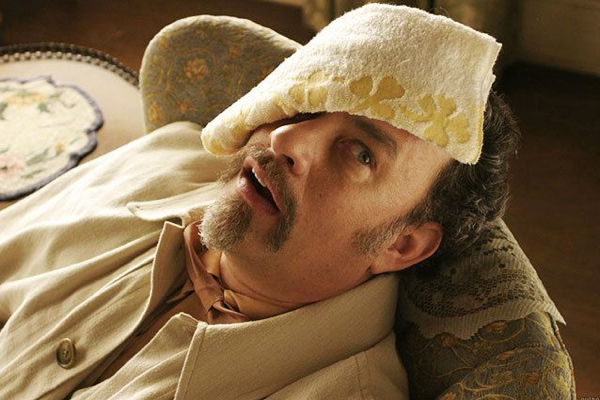Movie review by Greg Carlson
Remaking the 1955 Ealing gem of the same name, Joel and Ethan Coen transplant “The Ladykillers” to their own unique universe: an anachronistic pastiche of old and new, symbolically summarized in the glorious strains of traditional gospel and thumping hip-hop that play on the soundtrack. Similar in many ways to the ridiculously sublime Coen movies that exult in their off-center senses of humor at the expense of everything else, “The Ladykillers” is already being called a “minor” Coen film (whatever that exactly means). In any case, one’s enjoyment of “The Ladykillers” will almost certainly depend upon whether disbelief can be suspended enough to give Tom Hanks room to do his thing.
Hanks inhabits a bizarre criminal who goes by the name G.H. Dorr, Ph.D. Purporting to be a scholar of dead languages and Renaissance music, Dorr rents a room from devoted churchgoer and widow Marva Munson (Irma P. Hall) in order to set up a caper that requires tunneling through the walls of Munson’s root cellar in order to pilfer a large sum of cash from a nearby riverboat casino called the Bandit Queen. Predictably, one of the movie’s most satisfying running gags is the sight of Dorr and his motley crew scrambling to pick up their antique instruments whenever Munson descends into their basement practice space.
Dorr’s companions in crime appear to be anything but master thieves. Mustachioed demolitions expert and irritable bowel syndrome sufferer Garth Pancake (J.K. Simmons) is nearly as loquacious as Dorr, and his ostentatious manner ideally matches his khaki safari jacket. Pancake takes an immediate dislike to Gawain MacSam (Marlon Wayans), the “inside man” who nearly derails the plot when his fondness for the round posteriors of female casino guests gets him fired from the Bandit Queen’s custodial staff. The remaining two crooks are as quiet as Pancake and MacSam are gabby: The General (Tzi Ma) likely honed his skills digging tunnels in Vietnam, and Lump (Ryan Hurst) is a mountainous cretin rather used to taking a brutal beating on the gridiron.
While the storyline of “The Ladykillers” follows a predictable path, it becomes clear that the Coens are only interested in providing a platform on which to stage their verbal pyrotechnics. Like their best films, including the underrated “Miller’s Crossing” and “Barton Fink,” “The Ladykillers” is consistently stunning in its appreciation of weird diction and ornamental erudition. While Hanks, in his KFC-style Vandyke and layers of capes and topcoats, gets the showiest role, all of the actors adopt cadences and rhythms that are dazzling to hear. The Coens have never been shy about profanity, and it should be noted that “The Ladykillers” favors torrential outpourings of what Dorr would most likely call the harshest of imprecations and maledictions. Many will find the variety of foul tongues comic, others will think them coarse.
Visually, “The Ladykillers” returns to the meticulous compositional palette that defined much of the filmmakers’ early work. Longtime DP Roger Deakins bathes the movie in a golden glow that often serves as an ironic counterpoint to the gruesome activities that pile up in the final act (the God’s-eye view of the ever-present garbage barge is surely the film’s slyest, most satisfying motif). Several of the film’s other fanciful touches (including the “Sullivan’s Travels”-esque device of a portrait that changes its expression nearly every time it is shown) also contribute to the farcical tone. The final impact of the Coen brothers’ painstaking eccentricity – ideally realized in the tidy inevitability of the conclusion – pays off for fans like the slot machines on the Bandit Queen.
